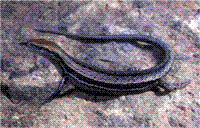Family
Scinciae (skinks)
Genus
Lampropholis
Species
guichenoti
Threats/Control Methods - Regional
In the short term, the expansion of urban areas may be detrimental to local population numbers, however, the lizards will recolonise suitable areas within the suburbs eventually.
Threats/Control Methods - Local
In the urban area, cats are a threat to individuals of the species.
Local/Urban Actions
Since leaf litter can be a limiting factor for Garden Skinks, leaving suitable amounts of leaves in gardens can be beneficial for the species.
Common name/s
Garden Skink
Distinguishing Features
The Garden Skink is grey-brown above with a darker line running down the centre of the back. A black stripe runs from the side of the head to above the legs. The head is often coppery in colour. The Garden Skink can grow to a maximum length of about 9cm, including tail.
Similar Species
The Delicate Skink (Lampropholis delicata ) closely resembles the Garden Skink, but the species' differ is their colouring, with the Delicate Skink being a coppery colour over the whole body and tail, and lacking the darker markings of the Garden Skink.
Distribution
The Garden Skink has a range extending from southeast Queensland, through eastern NSW and Victoria and into south-eastern South Australia. There are no recorded populations in Tasmania. The Garden Skink is present across most areas of the ACT, from high in the forests of the Brindabellas, to the suburbs of Canberra.
Country of Origin
Australia
Survey Techniques
Pitfall trapping and hand searching are methods typically applied to survey this species. Hand searching was used to locate the lizards at the ANU during the LSCC ecological survey.
Conservation (Pet/Pest) Status - National
A common species across non-arid areas of south-eastern Australia
Conservation (Pet/Pest) Status - Regional
Common around all areas of the ACT. Captive-bred Delicate Skinks may be kept by hobbyists with at least two years experience in keeping lizards (see Reptile Policy).
LSCCES Population
Common in the gardens and parks of suburban Canberra. Observed on the ANU campus in the 2003 LSCC ecological survey.
Associated vegetation community
Wet and dry sclerophyll forests, woodlands and grasslands.
Limiting Resources
The Garden Skink is adaptable to a wide variety of habitat situations; however, lack of leaf cover has been noted to limit numbers of the lizard.
Breeding
The Garden skink usually mates in spring, with up to four eggs laid, often in communal nests.
Behaviour
The Garden Skink is diurnal and mostly ground dwelling. It forages amongst leaf-litter, grass or rocky areas and can often be seen basking on rocks in urban gardens. In colder parts of its range (such as the higher altitude areas of the ACT), the Garden Skink becomes inactive during winter; in warmer areas it remains active year round.
Functional Group
Insectivore.
Food Species
The Garden Skink eats Ants and other invertebrates.
Predators
Snakes such as the Yellow-faced Whipsnake (Demansia psammophis) and Cats predate on the Garden Skink.
Interesting Fact
The Garden Skink is a good natural control of pests in urban gardens.
The species will rapidly wave its tail when threatened, possibly to distract predators away from its head and body. The lizard can lose its tail.
References - (reader suitability of references, P=Primary teachers, S=Secondary students, T=Tertiary students and researchers)
Books
Bennett, R. 1997. Reptiles & Frogs of the Australian Capital Territory, National Parks Association of the ACT, Woden. S, T
Cogger, H.G. 1996. Reptiles and Amphibians of Australia, Reed Books Australia, Melbourne. S, T
Online References
Greer, A.E. 2006. Encyclopedia of Australian Reptiles. Australian Museum Online, Version date: 7 August 2006. Thttp://www.amonline.net.au/herpetology/research/index.htm#encyclopedia
Researcher: Ian Rayner

 Top
Top Top
Top